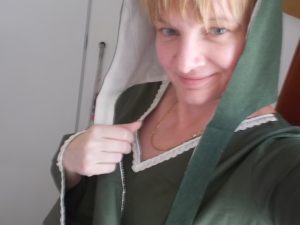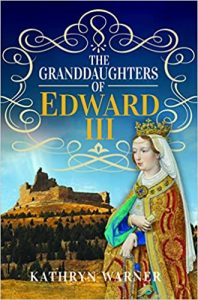Kathryn Warner is the author of ‘The Granddaughters of Edward III’ which will be published by Pen and Sword Books on 28 February.
Kathryn is the author of many books, including ‘Blood Roses: The Houses of Lancaster and York before the Wars of the Roses’, ‘Philippa of Hainault: Mother of the English Nation’, Living in Medieval England: The Turbulent Year of 1326’and ‘Edward II: The Unconventional King’.
Buy ‘The Granddaughters of Edward III’:
Follow Kathryn on Social Media
Kathryn’s website: Edward II
Facebook: Edward II
Twitter: @RoyneAlianore
Many thanks to Kathryn for answering my questions.
Why did you choose this subject for your book?
I love writing about medieval women, searching out references to them in documents, revealing their lives to a modern audience. Unfortunately, it’s often very difficult to find enough information to write a biography of one medieval person, but much easier to write a narrative of a group of women, and Edward III’s granddaughters were fascinating people who aren’t very well known. I thought they should be!
What does your book add to previous works covering this subject?
There’s little information available to an English-speaking audience about John of Gaunt’s daughters Philippa and Catalina, queens of Portugal and Castile. The two women are much more famous in Portugal and Spain than they are in their native land, and I had a great time reading medieval Portuguese and Castilian chronicles and letters in order to weave a narrative of the lives of these two powerful and influential women. Catalina was regent of Castile for her husband Enrique II, who was seven years younger than she, and later for their son Juan II. Philippa’s husband King João of Portugal issued many of his charters and grants with the words ‘together with the queen, Lady Philippa’, and Philippa’s children are known as the ‘Illustrious Generation’ who transformed Portugal from a rather insignificant European nation into a great maritime power. I hope readers enjoy learning about these two wonderful sisters as much as I enjoyed writing about them.
What surprised you most researching this book?
I wouldn’t call it ‘surprised’ exactly, as I’ve been researching and writing about medieval history for many years, but I’m still amazed and delighted to see how much influence medieval women could wield, and how many of them did so. There’s an outdated idea that women in the Middle Ages were little more than helpless, passive pawns of their fathers and husbands, and that their lives consisted of being expected to produce male babies regularly and not much else, but that’s absolutely not the case. Some of Edward III’s granddaughters were wealthy heiresses and landowners in their own right, and a few of them used their close family relationship to several kings of England (Richard II, Henry IV, Henry V) to benefit themselves and their associates. Some of them did as they pleased in their personal lives as well, such as Elizabeth of Lancaster choosing two of her three husbands, Constance of York having an affair with a nobleman a few years her junior, and Anne of Gloucester also choosing two of her three husbands and marrying them without royal permission.
Which granddaughter did you enjoy writing about the most?
I’ve always been especially fond of Elizabeth of Lancaster, duchess of Exeter, countess of Pembroke and Huntingdon, the second daughter of John of Gaunt. She was married at age 16 or 17 to a 7-year-old boy, John Hastings, heir to the earldom of Pembroke, but decided a few years later that she was sick of waiting for a child to grow up and married Richard II’s half-brother John Holland instead. Not too long after Holland was killed during a plot to restore Richard to the throne, taken from him by Elizabeth’s brother Henry IV, she married her third husband, Sir John Cornwall, one of the most famous English warriors of the early fifteenth century. Elizabeth’s life reads like it was invented for a novel. I’m also deeply interested in Elizabeth’s older sister Queen Philippa and their younger half-sister Queen Catalina, and the three Lancaster women were also the half-sisters of Joan Beaufort, countess of Westmorland, grandmother of two kings of England (Edward IV and Richard III). Philippa, Catalina and Joan were great fans of books and reading, something they shared with their brother Henry IV, and as a bookworm myself I find this very endearing.
Which granddaughter was the most difficult to write about?
That would definitely be the two youngest granddaughters of Edward III, the sisters Joan and Isabel of Gloucester, younger sisters of Anne, countess of Stafford, and daughters of Edward III’s youngest son Thomas of Woodstock. Joan died in 1400 at the age of only 15 or 16, and, with the exception of the arrangements for her marriage to Gilbert Talbot and the bequests she was left in her mother Eleanor’s will in 1399, there’s almost no information about her. Isabel was professed as a nun on her sixteenth birthday in 1402 and became the abbess of the Minoresses’ convent in London, and although I found some information about her, I was never able to determine even her approximate date of death. She was still alive in 1424. Supposedly Anne, Joan and Isabel had a younger sister, Philippa of Gloucester, who often appears on genealogy websites, but I never found any definitive evidence that she existed. If she did, she must have died very young.






































